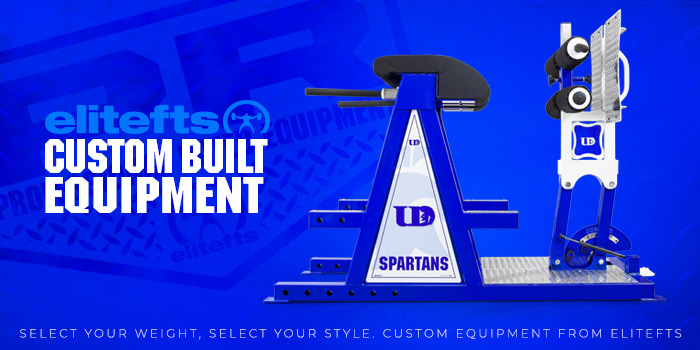
If you follow me on Instagram, you know I’ve set some grand goals for 2020: to total 1000 kilos raw and qualify for the ProRaw Big Dogs meet in Australia.
View this post on Instagram
Now, that’s going to take adding a lot of strength – so much so that to even have a shot, I’ll have to add a lot of size as well. Justin Harris is guiding me on the diet aspect of that, but I thought it would be cool to take a closer look at a typical training session so I could share some of the details about how I combine training for strength and size in a single day.
A Sample Leg Day
This is my workout for tomorrow – one I’m pretty darned pumped about – so it’s the perfect opportunity to share. Here’s how I’m structuring it:
- Warmup. Warming up is crucial to both performing at your best on any given day, and for preventing injuries in both the short and long term. My warmup consists of 3-5 minutes on the stationary cycle, followed by some light work for my problem areas (shoulders and knees): TKEs, loaded supination, my favorite adductor stretch, and occasionally some light hammer curls.
Then I’ll move on to a warmup exercise. Right now, that’s walking lunges holding 30-50 pound kettlebells. I’ll shoot for three sets of ten lunges per leg (so 20 total per set). I really like walking lunges because they get a quad pump going super fast, but they also require solid rooting mechanics, they involve a great deal of adductor and glute work, and they don’t require heavy loading to be effective.
If I were to generalize across all my sessions, I’d say that the three things I look for in a good warmup movement are:
- Ease of developing a mind-muscle connection and developing a good pump
- Involvement of multiple muscle groups that will also contribute to my major movement for the day
- Low loading requirements
This combination both helps to improve performance, and, in my opinion, joint health, in the short and long terms.
- Main movement. For right now, I’m using paused squats with the Yoke Bar. This isn’t a competition movement, but I’m in the very early stages of the offseason, so it’s not as important that I’m practicing my straight bar squatting technique. Instead, I prefer to save strain on my shoulders and shift emphasis in the squat to my weak point: the quads. The Yoke Bar does both very effectively. If you’re trying to find a good movement to target your own weaknesses, make sure to check out the video below:
I like to use a waved rep scheme on my main movements, and load using a combination of RPEs and percentages. I explain the benefits of both of these in my Unf*ck Your Program course, which you can find on my website (linked in my author bio and also if you click through to the YouTube video embedded above).
- Supplemental movements. Here’s where the size part comes in. With the main movement, I’m only concerned with moving as much weight (safely) as possible. With these movements, I’m trying to achieve more muscular growth, so I focus on the muscle that I’m working, not the movement itself. I know this sounds like a subtle distinction, but it’s very important. This video explains in more detail:
Ultimately, I highly encourage you to just try it out for yourself, and make sure to give a good two or three months before you evaluate whether it’s working for you or not. In my experience, that’s about the minimum time you’ll need to really get the hang of it.
When choosing movements, I’m focusing on correcting asymmetries both in my physique and my competition movement patterns. Again, make sure to check out the “magic exercises” video above for help with this, but basically, it comes down to these points:
- Do what you suck at. If you’re already strong at a non-competition movement, chances are, improving it even more isn’t going to fix your weaknesses. Swallow your ego and do the hard stuff.
- Stay consistent. Change doesn’t happen overnight. Instead of rotating movements every couple of weeks (pretty standard in many powerlifting programs), stick with them until you’re absolutely sure progress has stalled.
Here are my movements for leg day:
- Banded leg press. I put my feet up way high on the platform to hit my quads and hamstrings with the same movement, make sure to use a full range of motion, and do 2 brutal sets of 20. Usually I have to stop to catch my breath a few times during the set, but that’s okay.
- Reverse hyper. I perform them in exactly this way for 3 sets of 8-12.
- Calves. Justin, if you’re reading this, I promise I train calves.
Now, I know all of that probably doesn’t seem like a whole lot of work… but trust me: if you’re training intensely, you’re wiped out after the squats alone. Making it through the supplemental movements without puking is an accomplishment in and of itself.
Next month, I’ll discuss how I structure my microcycle (in this context, my training week). If you have specific questions you’d like me to address in that blog post, please leave them in the comments below!










Really appreciate the updates to your training. I'm currently structuring my sessions with a similar approach using your Think Strong periodization for my main work then filling in the blanks with a more Mountain Dog style for hypertrophy.
My question is: are you performing back off sets of your main movement after your top sets of the day to backfill the volume?